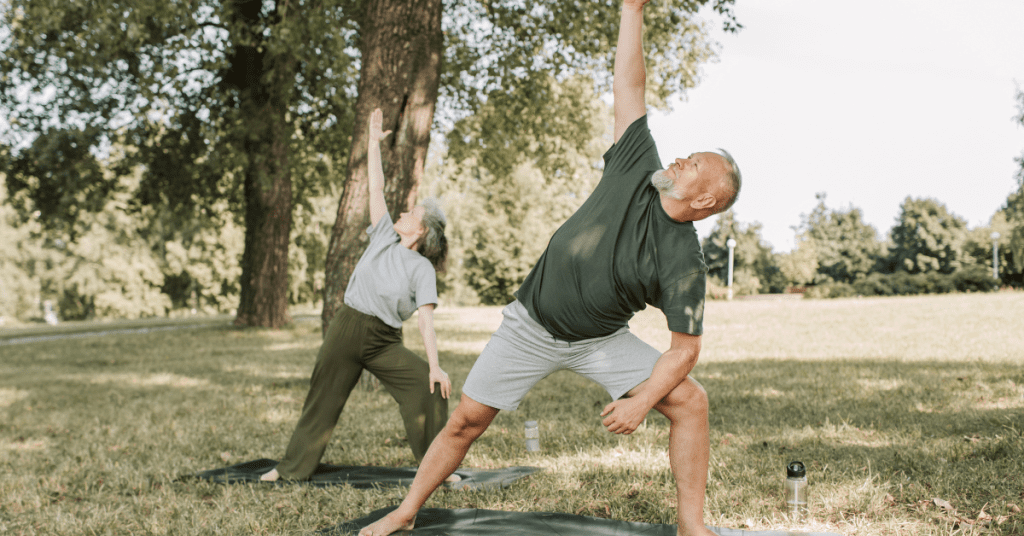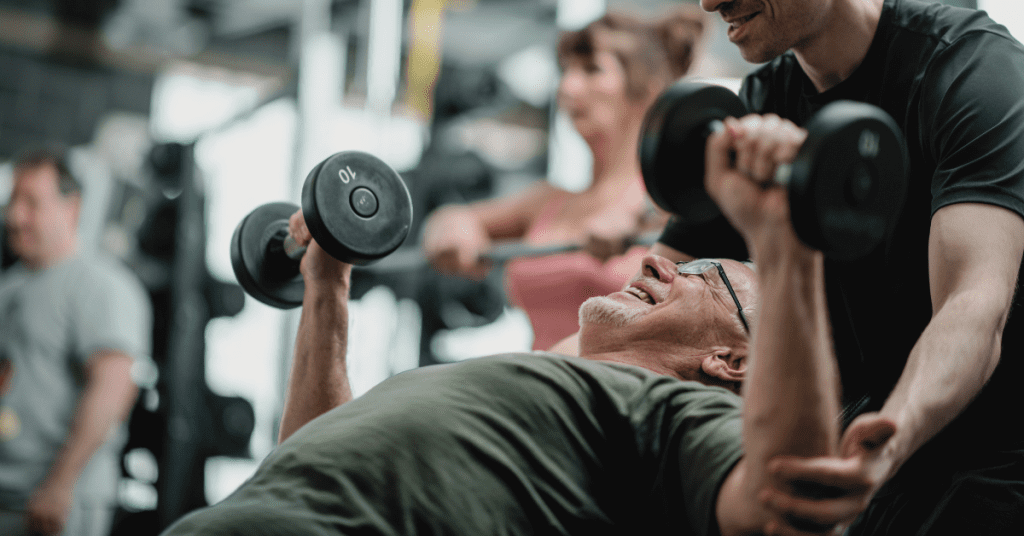As we age, it’s normal to experience loss in muscle mass, strength, and flexibility. This process can begin as early as in your 30s and 40s. However, there are several things we can do to slow down this process and even build muscle as we age.
Why is it essential to maintain muscle mass?
Maintaining muscle mass as we age is crucial for overall health, mobility, and independence. Muscle strength supports daily activities, such as walking, climbing stairs, and carrying groceries, which are essential for a good quality of life. It also helps protect against falls and injuries, which become more common with age due to decreased balance and bone density. As we age, we must consider how we want to live in our 70s, 80s, and even 90s. Personally, I want and plan to maintain my independence, which is why we all need to start as early as possible to take care of our health.
Bone density loss as we age
Many people begin to experience bone loss after age 50. Bone density loss refers to a decrease in the mineral content of bones, called osteopenia. Osteopenia often develops silently, with no noticeable symptoms until a fracture occurs. Factors contributing to osteopenia include aging, a sedentary lifestyle, inadequate intake of calcium and vitamin D, smoking, excessive alcohol consumption, and certain medications or medical conditions.
While it is not as severe as osteoporosis, osteopenia is a significant warning sign, highlighting the need to take proactive measures to improve bone health. Early detection through bone density tests can help manage osteopenia effectively and prevent its progression to osteoporosis.
Therefore, this would be a good time to discuss getting a bone density baseline test with your healthcare provider. A bone density baseline test is a non-invasive procedure for assessing bone health. Establishing a baseline is particularly important for individuals at risk of osteoporosis, including postmenopausal women, older adults, and those with a family history of bone diseases. A bone density test is no different than establishing a baseline mammogram.
The results provide a benchmark for future comparisons, enabling early detection of bone density loss and guiding preventive measures. A bone density test can help healthcare providers recommend interventions to maintain or improve bone strength and reduce the risk of fractures.
Unfortunately, our health care system typically recommends you take your bone density baseline at 65. That’s 15 years after you begin to lose bone density. As a cancer survivor, I am a firm believer in advocating for my health. I had my baseline taken at 40 for my mammogram and 50 for my bone density. If something is not moving in the right direction, the sooner we know, the sooner we can take corrective action.
Because of the possibility of early detection, it’s crucial that you establish a strong relationship with your healthcare provider and constantly advocate for your health. You can’t afford to outsource your health to someone else. Your body and health are your responsibility; no one else will ever be as invested in your well-being as you.

What is Osteoporosis?
Osteoporosis is a severe condition in which bone density is significantly reduced. This condition makes bones weak and even brittle, increasing the risk of fractures. While osteoporosis is more common in older adults, especially postmenopausal women, it can affect anyone. Men need to be concerned about osteoporosis, even though it is often viewed as a condition primarily affecting women. While women are at higher risk due to hormonal changes after menopause, men are not immune to bone loss.
Men typically experience a gradual decline in bone density as they age, with significant bone loss often beginning after age 70. Risk factors such as low testosterone levels, smoking, excessive alcohol consumption, poor diet, sedentary lifestyle, and certain medical conditions or medications can further increase their risk. Men are also more likely to remain undiagnosed until they suffer a fracture, as men are less frequently screened for osteoporosis.
Calcium and Vitamin D for strong bones
Maintaining strong, healthy bones is essential for overall well-being and mobility throughout our lives. Calcium and vitamin D play a crucial role in our bone health.
Why Calcium Is Essential
Calcium is the primary mineral found in bones and is vital for maintaining their structure and density. Almost all of our bodies’ calcium is stored in our bones and teeth, providing the strength they need to withstand daily activities. Think back to when you were a small child, and your mother told you to drink your milk so you would have strong bones. Well, she was right.
Calcium also supports vital functions such as muscle contraction, nerve transmission, and blood clotting. When dietary calcium is insufficient, the body draws from its calcium reserves in the bones, weakening them over time.
Just before my cancer diagnosis, I noticed that my nails would constantly break or split down the middle. It was the first warning sign of my calcium deficiency. In addition to having my thyroid removed because of cancer, I also had two of my parathyroid glands removed, which led to me having ongoing issues with low calcium levels.
Good sources of calcium include dairy products like milk, cheese, yogurt, leafy greens, almonds, fortified plant-based milk, and tofu. The recommended daily calcium intake for adults is about 1,000–1,200 mg, depending on age and sex.
You can also take calcium in supplement form. However, be cautious, particularly if you don’t know your current calcium levels. I can tell you from personal experience that too much calcium is just as bad as a deficiency. As I am tested regularly, it’s easy to identify when my calcium levels are in excess from taking too much calcium, enabling my healthcare provider and I to take corrective action. Know your numbers! Always consult with your healthcare provider before taking any supplements.
The Role of Vitamin D
Vitamin D is just as critical as calcium for bone health because it facilitates calcium absorption from the digestive system into the bloodstream. Without sufficient vitamin D, the body cannot effectively utilize dietary calcium, no matter how much is consumed.
Vitamin D is unique because the body can synthesize it through exposure to sunlight. However, factors like limited sun exposure, aging, darker skin tones, and geographic location can hinder vitamin D production. In addition, we know that too much exposure to the sun can lead to skin cancer. Therefore, we must rely on other methods to obtain the appropriate amount of vitamin D our bodies require.
Foods such as fatty fish (e.g., salmon, mackerel, and sardines), egg yolks, and fortified products can help provide vitamin D. Many individuals also benefit from supplements to meet the daily recommended intake of 600–800 IU for most adults. Again, know your numbers before taking any supplements.

Vitamin D and Calcium, you need both
Vitamin D and calcium work hand in hand to build and maintain bone density. Vitamin D ensures calcium is absorbed efficiently, while calcium provides the structural material for bone strength. A deficiency in either can lead to compromised bone health, increasing the risk of osteoporosis, fractures, and other complications.
Vitamin D and calcium are the cornerstone of strong, healthy bones. By prioritizing these nutrients through diet, lifestyle, and supplementation when necessary, you can protect your skeletal system and reduce the risk of bone-related disorders. A proactive approach to bone health ensures greater strength, stability, and independence as you age.
Tips for Healthy Bones
Consume a Balanced Diet: Include calcium-rich foods and those fortified with vitamin D to meet daily requirements.
Get Regular Sunlight: Spend 10–30 minutes outdoors in sunlight several times a week, depending on your skin tone and location. Make sure you apply sunscreen.
Exercise Regularly: Weight-bearing and resistance exercises stimulate bone formation and improve bone density.
Consider Supplements: If dietary intake or sun exposure is inadequate, consult a healthcare provider about taking calcium and vitamin D supplements.
Avoid Bone Depleters: Limit smoking, alcohol, and excessive caffeine, as these can negatively impact bone health.
Strength training
Strength training is a workout routine focusing on building muscle strength using light weights, resistance bands, or just your body weight. It’s a powerful tool in building bone density and muscle mass. It also strengthens the muscles around the bones, improving balance, posture, and stability, which reduces the risk of falls and fractures. Therefore, it is essential for both men and women to prioritize bone health through regular weight-bearing and strength-training exercises.
It’s also worth noting that muscle plays a vital role in metabolism, aiding in weight management and reducing the risk of chronic conditions like type 2 diabetes and heart disease. Preserving muscle mass can improve energy levels, enhance posture, and promote mental well-being, allowing older adults to stay active and engaged in their communities. Regular strength training and a protein-rich diet are key to maintaining muscle health as we age.
Weight-bearing exercises
Weight training strengthens muscles and stimulates bone growth, helping to counteract the natural decline in muscle mass and bone density that occurs with aging. Additionally, it supports joint health, improves metabolic function, and enhances cardiovascular health, contributing to a better quality of life. Before starting a weight training program, consult a healthcare provider or fitness professional to ensure safety and proper technique. Focus on exercises that target major muscle groups and use proper form to prevent injury.
It is essential to begin gradually to minimize the risk of injury. Recovery from an injury as we age takes time. Start with light dumbbells or utilize your own body weight to perform exercises. As you build strength and confidence over time, you will be able to progress safely to heavier weights.
Women should not hesitate to incorporate weight training into their fitness routines. Contrary to common misconceptions, lifting weights will not result in a masculine appearance. Women naturally have significantly lower levels of testosterone compared to men, and these levels tend to decrease further with age.
As a professional bodybuilder, in my 70s, I can attest to the fact that lifting weights will not negatively transform your physique. To the contrary, weight training helps improve muscle tone, enhances strength, and promotes a leaner physique by increasing calorie expenditure during and after training. Embracing resistance exercises can lead to improved health, confidence, and overall well-being.

Safe and effective weight training exercises
Focus on exercises that target major muscle groups and use proper form to prevent injury. Below are a few suggestions.
Squats & Step-ups: Targets quadriceps, hamstrings, glutes
Pushups: Targets chest, shoulders, triceps
Seated Rows with bands: Targets back, shoulders, biceps
Overhead Shoulder Press: Targets shoulders, triceps
Planks: Targets core
Tips for success
Start slowly: Start with light weights or resistance bands. When I first started lifting, I thought 5 lbs was heavy. That’s a bag of sugar. Remember, Rome wasn’t built in a day. Be patient. As you built strength, gradually increase the weight.
Focus on form: This is so important and cannot be stressed enough. Proper form is key to avoiding injury and ensuring you are training the muscle correctly. Ever wonder why there are mirrors everywhere at the gym? Use them to check your form.
Rest and recovery: Allow 48 hours between sessions targeting the same muscle group to promote recovery and growth.
Conclusion
Building muscle after 60 is a vital component to maintaining health, mobility, and independence as we age. Strength training and a diet rich in protein, calcium, and vitamin D will help combat age-related muscle loss, enhance bone density, and support joint health.
Starting training gradually and focusing on proper technique to ensure safety and effectiveness, while progressively increasing resistance builds strength over time. Regular weight training not only improves physical function but also boosts metabolism, enhances balance, and reduces the risk of falls and injuries. By committing to a consistent and well-rounded fitness routine, adults over 60 can enjoy greater vitality, resilience, and quality of life.






0 Comments